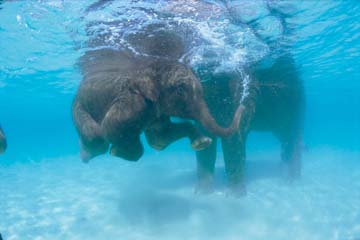I find this surprising as the whale has such a tiny amount of nitrogen in its body during the dive.
A diver absorbs lungfuls of nitrogen at 3 atmospheres for as long as they are at 100 ft. Thus there is pleanty of nirtogen about to saturate the tissues. So we need to surface very slowly to allow all the extra nitrogen we have absorbed while under preasure to escape.
A whale has only one lungful. While it is a big lung it is at 1 atmosphere. There is no extra nitrogen to saturate the tissues.
As the whale did not get the bends at the surface the concentration of nitrogen throughout the body must be insufficient to cause bubbles.
At any depth below the surface a greater concentration of nitrogen is necessary for it to form bubles.
Therefore for a bubble to form below at > 1 atm the body must be concentrating the nitrogen in one place. Why?
As whales can be up to 100ft long does this mean that if the stand on their tails then surface they can get the bends without diving? What a bummer that would be.









